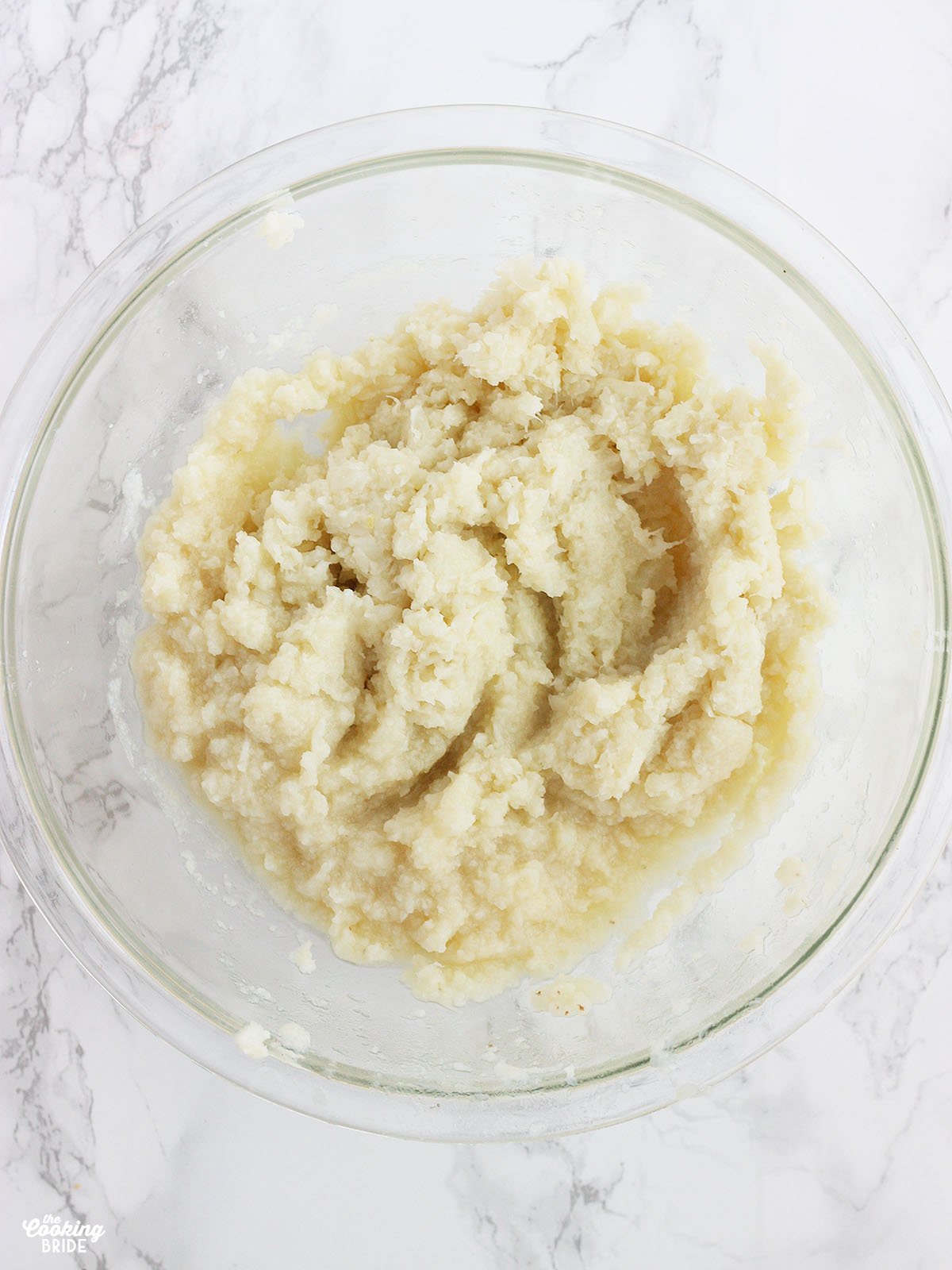Cheese and Cauliflower Gratin
Cheese and cauliflower gratin is a tasty substitute for mashed potatoes. It is garlicky, buttery, cheesy, and the crispy breadcrumb topping adds a yummy crunchy texture.
This post may contain affiliate links. Click here to learn more about how affiliate links are used on this site.
Cauliflower is one of those vegetables I refused to eat at a kid. As an adult, I have acquired a taste for it. I will actually eat it raw. Willingly. But I have heard that mashed cauliflower, when prepare the right way, can mimic the flavor of mashed potatoes. I love some mashed potatoes, but if I can find a way to incorporate more cauliflower into my diet, I’m going to try it.
Health Benefits of Cauliflower
Cauliflower has become a popular low carb swap for some of the most popular comfort foods. It’s also packed with nutrients. Cauliflower is loaded with Vitamin K, which is good for strong bones and preventing osteoporosis. It can help reduce high blood pressure in addition to boosting your immune system and reduce your risk for cancer.
Using Frozen Riced Cauliflower
When this recipe was first published in 2012, frozen riced cauliflower was not yet a thing. Today, it has become extremely popular and usually very easy to find in the frozen vegetables section of your grocery store. You can absolutely skip steaming and mashing your own cauliflower and just use frozen.
One medium head of cauliflower will produce approximately 4 cups of riced cauliflower. The average package of frozen is 10 ounces, so you’ll use 1/2 the package. Cook it according to package directions, then skip to Step Four in the recipe.
Steaming Cauliflower Preserves all Those Nutrients
If you want to steam your own cauliflower, keep reading! Did you know when you boil vegetables, all the nutrients leech out into the water? Unless you plan on drinking the water you boiled the veggies in, you’re defeating the purpose of eating veggies in the first place.
Steam causes less damage to the veggie as it cooks, resulting is less nutrient loss. Steaming on the stove top is simple. All you need is a steam basket and a lidded saucepan that can accommodate the basket. Add just enough water to the bottom to the saucepan so that it comes up just to, but does not touch, the bottom of the steamer basket. Add your veggies to the basket, bring the water to a boil, then reduce the heat to medium and steam for 20 minutes until the cauliflower can be easily stabbed with a fork.
If you own an Instant Pot, it’s even easier. You’ll be using the pot-in-pot method here. Place the rack that came with your Instant Pot into the bottom of the metal insert. Add one cup of water. Next, place a pressure safe bowl, such as a Pyrex dish or metal bowl onto the rack in the insert. You can also purchase a steamer basket that fits the Instant Pot. Fill the bowl with the cauliflower. Cover and select the STEAM option. Allow the pressure to release naturally for about 10 minutes.
Mashing the Cauliflower
I want the texture of the cauliflower to be as close to that of mashed potatoes as I can get it. I like to run my cauliflower twice through a food mill. A food mill is a device that strains and mashes food. It’s handy for making things like applesauce, tomato sauce, or purees. It comes with a bowl, three plates with small, medium and large holes, and a crank.
I run my cauliflower once using the plate with medium holes, then again with the plate with small holes. Why do I do it twice? If you start with whole cauliflower and try to run it through the plate with small holes, it will get clogged. Using the medium plate breaks it down into small pieces. I run it through the second time to get even smaller pieces. It produces a creamy texture similar to mashed potatoes.
Don’t run out and buy a food mill if it’s not something you think you will ever use again. You can also mash your cauliflower to your desired texture using a fork or a potato masher.
How to Make Cheese and Cauliflower Gratin
Now that we’ve gotten the prep work out of the way, we’re ready to assemble the gratin. First, preheat the oven to 350 degrees. While you’re waiting for the oven to preheat, stir in the cheeses, butter, garlic powder, salt and pepper to taste. Pour cauliflower into a greased 8 x 8 x 2-inch greased casserole dish. You can also use a 10-inch greased cast iron skillet like I did.
Next, melt 1/4 cup, or four tablespoons, of unsalted butter. Add one cup of Panko breadcrumbs and stir until the breadcrumbs are coated with the butter. Spread the breadcrumbs in an even layer over the top of the gratin.
I prefer to use regular breadcrumbs for recipes that require a binding agent, such as meatloaf or meatballs. But when it comes to a toasty, crispy topping, I always opt for Panko breadcrumbs.
Panko breadcrumbs are a type of Japanese breadcrumbs that are lighter and crispier than regular breadcrumbs. They really retain their crunchy texture, even when baked, which is why I love to use it as a topping for this cauliflower gratin. You can typically find Panko breadcrumbs in the spice and baking aisle right next to regular breadcrumbs.
Bake the gratin uncovered for 40-50 minutes. When you pull it out of the oven, the breadcrumbs should be golden brown. The cauliflower gratin will be very hot when you pull it out of the oven, so I suggest letting it sit for five minutes before serving.
Looking to make this a low carb option?
Omit the breadcrumbs and add another cup of shredded cheese to the top. You could use all shredded colby-Jack, all Parmesan, or a nice mixture of both.
Prep ahead
Cheese and cauliflower gratin can be made up to a day ahead of time. Just skip the breadcrumb topping until right before you are ready to put it in the oven. The recipe can also easily be doubled to serve a crowd and still produce the same great results.
This gratin is garlicky, buttery, cheesy, and the crispy breadcrumb topping adds a yummy crunchy texture. It’s a dish my whole family enjoys.
Storage, Freezing and Reheating
Storage. I don’t recommend storing the gratin in a cast iron skillet. It could cause the skillet to rust. Instead, transfer leftover gratin to a storage container with a lid within two hours. Consume within one week.
Freezing. This gratin freezes extremely well, baked or unbaked. Cover the top of the gratin with aluminum foil. Consume within three months.
Reheating. Allow the gratin to thaw overnight in the refrigerator. If unbaked, follow instruction #7 in the recipe. If baked, preheat the oven to 350 degrees and bake for 15-20 minutes until the gratin is heated through.
You Might Also Like:

Cheese and Cauliflower Gratin
Ingredients
For the cauliflower:
- 1 large head of cauliflower broken into florets
- 3/4 cups shredded Parmesan cheese
- 1/2 cup shredded Colby-Monterey Jack cheese
- 3 tablespoons unsalted butter cubed
- 1/2 teaspoon garlic powder
- 1/4 teaspoon Montreal steak seasoning
- 1/4 teaspoon thyme leaves chopped
- Salt and pepper to taste
For the breadcrumb topping:
- 1 cup Italian-style panko (Japanese) bread crumbs
- 1/4 cup unsalted butter melted
Instructions
- Fill a large stockpot about 1/4 the way with water. Bring the water to a boil over high heat
- Place the cauliflower florets in a large steam basket over the pot. Cover. Reduce the heat to medium. Steam the cauliflower until very tender, about 20 minutes.
- Preheat the oven to 350 degrees.
- Transfer the cauliflower to a large bowl. Mash with a potato masher, ricer or process through a foodmill.
- Stir in the cheeses, butter, garlic powder, salt and pepper to taste. Pour the cauliflower into a greased 8 x 8 x 2-inch greased casserole dish.
- Combine the breadcrumbs and melted butter. Season with salt and pepper to taste. Spread the breadcrumbs over the top of mashed cauliflower.
- Bake uncovered for 40-50 minutes until the cheeses are melted and the topping is golden brown.









You won’t be dissappointed, Traci!
Oh I have sooooo been meaning to try a cauliflower gratin. I seriously want this on our holiday table this year! Just pinned and can’t wait to make it…thanks!
Ah, yes! This is much easier! I hope you do try it, Beth.
What a great side dish for any dinner! Cannot wait to try this!
I am a huge cauliflower fan!I’m definitely going to try this! I make a cauliflower with cheese sauce, but it requires a bechamel! What a pain! Your version looks so much easier!